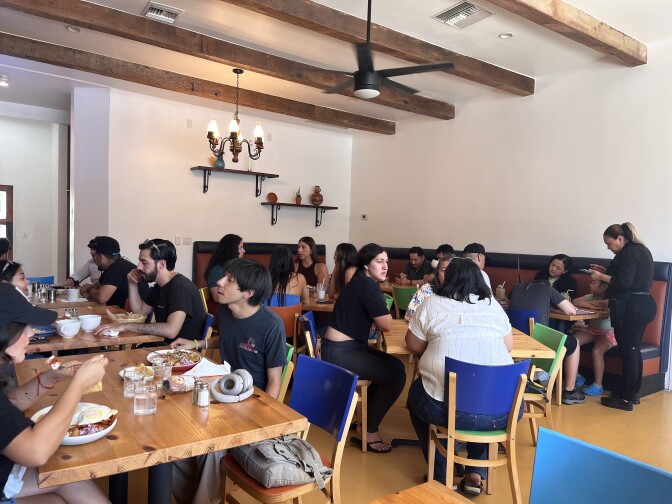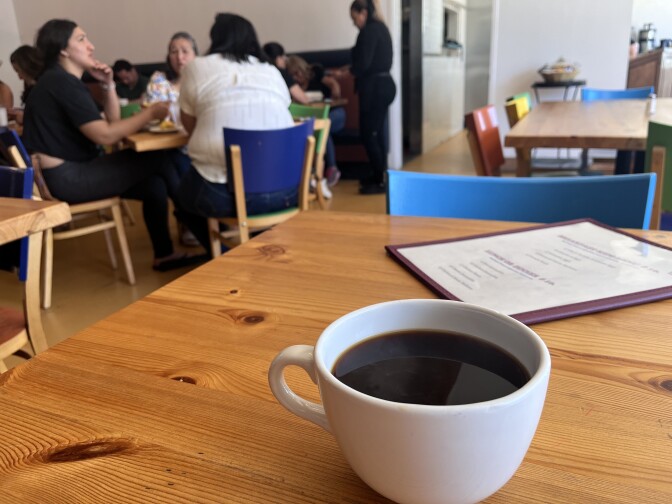Truth matters. Community matters. Your support makes both possible. LAist is one of the few places where news remains independent and free from political and corporate influence. Stand up for truth and for LAist. Make your year-end tax-deductible gift now.
Moles La Tía is back after six years — and East LA is eating again

This story was originally published by Boyle Heights Beat on Sept. 8.
For nearly six years, fans of Moles La Tía stalked Yelp and Instagram, messaged owners and drove past the shuttered East L.A. restaurant, peering inside a mostly untouched dining room in search of signs of life.
“I was devastated,” said Marco Klug, 37, of Monterey Park, who was introduced to the restaurant by his mother and tías from East L.A. “It felt like a community loss. My family celebrated everything here. …The food tastes like my abuelita and tías made it. If you know how elaborate Mexican cuisine can be, you know how impressive having coffee and pistachio mole on a menu is. It serves quality dishes made by Mexicans for Mexicans.”
On Aug. 21, the wait finally ended. Moles La Tía quietly reopened its doors — and within days, word had spread.
As if it never closed
On a recent weekend, the restaurant’s dining room buzzed with life. Families shared chilaquiles and café de olla, friends caught up over fried eggs and fresh tortillas, and couples split fresh pan dulce.
It was as if the Cesar Chavez Avenue gem — one of the few restaurants on the east side specializing in mole — never closed.
“We’ve been coming here since my son was in middle school. He already graduated from college,” said Jesus Manzo, a San Fernando Valley resident who was eager to return with his family since he heard the restaurant had reopened.
Building a legacy, navigating setbacks
Alejandra Reyna opened Moles La Tía in 2006 with her husband, Jesus Gabriel Huerta, and took over full operations in 2020. Together, they developed the restaurant’s signature mole recipes with Rocío Camacho — renowned for her mole and a former part owner.
Aside from mole, Reyna believes the restaurant helped spark the popularity of chilaquiles at restaurants on the east side.
“Nobody talked about chilaquiles before us, and now they’re everywhere,” Reyna said.

But keeping the business alive — and getting it back open — was anything but easy.
In October 2019, the restaurant closed for remodeling. Plans to add a handicap restroom, backdoor and prep room were derailed when the COVID-19 pandemic hit. Contractors and employees didn’t show up to work and permits expired. Reyna and Huerta said health inspectors made matters worse.
“It’s very difficult to open a business here,” said Huerta, 60, who was born in East L.A. and spent part of his youth in his parents’ native Mexico. At 18, he returned to his roots to run El Gallo Bakery, which his mother opened in 1949.
”We don’t have a government or any representatives," Huerta said. "Nobody listens to you. They just come and hit you with more fees, more licenses, more requirements. It’s non-stop.”
Huerta, a proponent of East L.A. cityhood and member of the Maravilla Community Advisory Committee, owns several local businesses in the same corridor, including El Gallo Bakery, El Gallo Grill and El Gallo Plaza.
After navigating the pandemic and meeting strict health codes, Reyna was finally ready to reopen. Then ICE raids hit the neighborhood.
“The health inspector called and said she was going to close my permit because I hadn’t reopened,” Reyna said. “I told her ICE prevented my employees from leaving the house. They were scared. She thought I was going to sell hot dogs or hamburgers. I do everything from scratch. It’s really hard to train employees how to make mole and salsas, and we have nine different kinds.”

Same flavors, brighter space
When Reyna posted the restaurant’s reopening on Instagram, she was flooded with messages from excited customers.
“They say this is the taste they’ve been waiting for,” said Reyna, who gets emotional when customers return. “That makes my heart beat. I’m honored.”
The menu remains the same: chilaquiles topped with eggs, creamy Peruvian refried beans and potatoes in lieu of rice. A warm corn quesadilla accompanies many plates. Signature dishes include las enmoladas tricolor and camarones sautéed with mushrooms and jalapeños in a creamy white wine sauce.
The star, of course, is the mole — vibrant, traditional Pueblan and Oaxacan varieties made with ingredients ranging from pistachios and white chocolate to coffee and coconut. Their velvety horchata is topped with toasted pepitas and a hot pink swirl of agua de tuna. For dessert: coconut, pistachio and elote flan.
Just before closing in 2019, the walls were painted white, making the mosaic and wooden accents pop and the dining room brighter. Since then, two restrooms have been added with saltillo tile floors that lead to a wheel chair accessible back entrance.
The basket of fresh pan dulce is still there, but the tía statue many remember is missing.
“We’re working on it,” Reyna laughs. “It’s being restored.”
Location: 4619 E. Cesar E Chavez Ave., East L.A.
Hours: Soft opening Monday through Sunday, 8 a.m. to 3 p.m.














